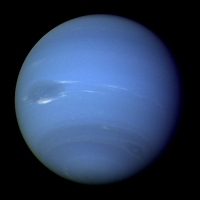Neptune
 |
Origin of name Neptune is named after the Roman god of the sea.
Discovered by
Satellites |
Physical Properties
| Property | Unit | Value | Earth = 1 |
| Equatorial radius, 1 bar level | km | 24 764 | 3.883 |
| Polar radius, 1 bar level | km | 24 341 | 3.829 |
| Flattening | 0.01708 | 5.10 | |
| Mass (x1024) | kg | 102.43 | 17.147 |
| Volume (x1010) | km3 | 6254 | 57.74 |
| Mean density | kgm-3 | 1638 | 0.297 |
| Gravity at equator, 1 bar level | ms-2 | 11.15 | 1.14 |
| Escape velocity | kms-1 | 23.5 | 2.10 |
| Magnetic field at equator (x10-4) | T | 0.14 | 0.46 |
| Magnetic dipole moment (x1017) | Tm3 | ~ 2.1 | ~ 25 |
| Tilt of dipole axis | ° | 46.8 | |
| Dipole field centre offset from planet centre (equatorial radii) | 0.55 | ||
| Number of natural satellites | 13 |
Orbital Parameters
| Property | Unit | Value |
| Perihelion (x106) | km | 4444.45 |
| Aphelion (x106) | km | 4545.67 |
| Mean distance from the Sun (x106) | km | 4495.06 |
| Mean distance from the Sun | AU | 30.05 |
| Eccentricity | 0.0113 | |
| Sidereal orbit period | y | 164.79 |
|
Sidereal rotation period Magnetic coordinates (Voyager 2) |
h | 16.11 |
| Length of day | h | 16.11 |
| Orbit inclination to Ecliptic | ° | 1.769 |
| Mean orbital velocity | kms-1 | 5.43 |
| Maximum orbital velocity | kms-1 | 5.50 |
| Minimum orbital velocity | kms-1 | 5.37 |
| Axial tilt | ° | 28.32 |
Notes
-
Sidereal orbit period
The time taken by the planet to complete exactly one orbit around the Sun with respect to the celestial sphere. -
Sidereal rotation period
The time in which the planet rotates around its axis exactly 360° with respect to the celestial sphere. -
Length of a day
Defined as the time between two successive sunrises over the meridian. -
Magnetic dipole moment
Calculated as the ratio of the magnetic field strength at the equator divided by the cube of the equatorial radius.
Last Update: 1 September 2019
